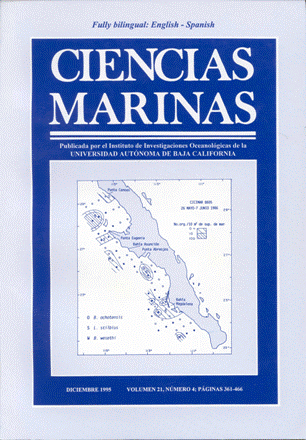Feeding habits of the spiny Lobster (Panulirus interruptus Randall, 1840) in Bahia Tortugas, Baja California Sur
Main Article Content
Abstract
The feeding habits and nutritional state of the spiny lobster (Panulirus interruptus) were studied; 71 specimens, ranging from 57-132.2 mm cephalothoracic length, were collected on a seasonal basis in August and November 1986 and February and May 1987, in Bahía Tortugas, Baja California Sur. The index of relative importance, which combines the frequency and weight of the different components, was used to analyze the diet composition. The nutritional state was assessed by means of a condition factor, calculated by dividing the individual total weight by the caparace length, and the reserve food index, which is the hepatopancreas weight divided by the individual total weight. Panulirus interruptus showed an omnivorous diet, changing from carnivorous to herbivorous or even scavenger, depending on the environmental conditions. The diet consisted mainly of gastropods, fish remains, decapods and red and brown algae. Seasonal variation was observed in the feeding patterns of both sexes. Apparently, this variation was associated with the fluctuations in the availability of food items and with the home range of each sex. The condition factor registered the maximum value during the winter (x = 407.7, sd. = 30.27), whereas the reserve food index showed the lowest value in the spring (x = 1.55, s.d. = 0.48). The differences observed are apparently related to the reproductive stage and to the cyclical movements of the lobster population, from shallow to deeper waters, throughout the year.
Downloads
Article Details
This is an open access article distributed under a Creative Commons Attribution 4.0 License, which allows you to share and adapt the work, as long as you give appropriate credit to the original author(s) and the source, provide a link to the Creative Commons license, and indicate if changes were made. Figures, tables and other elements in the article are included in the article’s CC BY 4.0 license, unless otherwise indicated. The journal title is protected by copyrights and not subject to this license. Full license deed can be viewed here.

